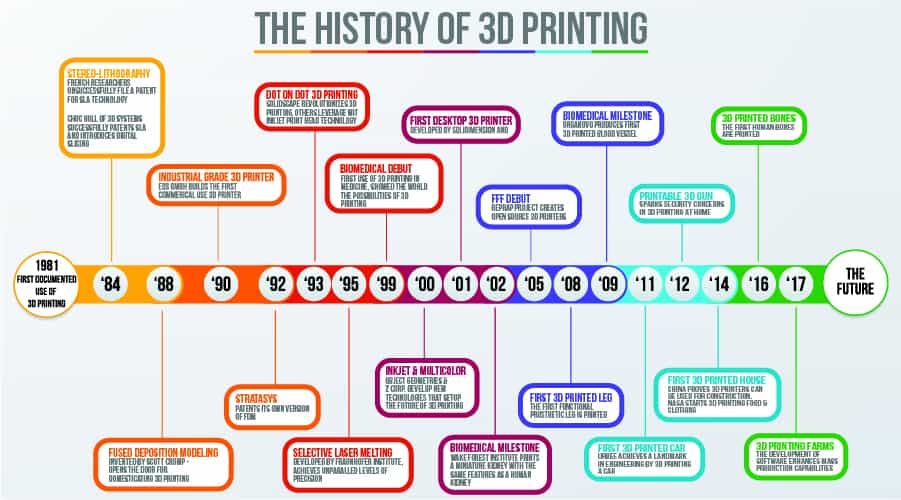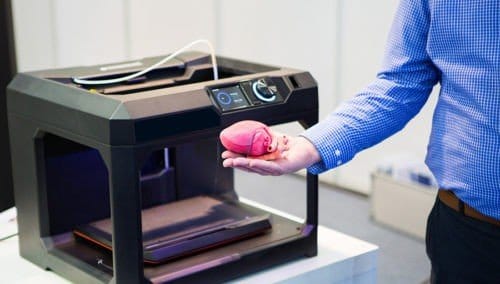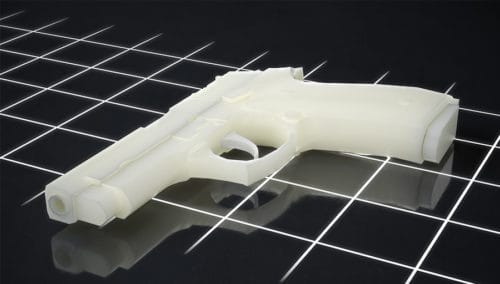The history of 3D Printing is older than you think. When it comes to learning about something new, I like to start at the beginning. That’s why we’ve prepared a bit of a 3D printing history timeline for you.
3D Printing is a modern marvel. If you thought it really got its start in the last few years, you’re wrong. 3D Printing has been around much longer and has exploded in recent years. Even though the history of 3D Printing is older than most people think, it’s still had a relatively quick rise compared to our past technological advances. Take a look.
Our ancestors took 3 million years to create stone tools and the wheel during the stone age. The metal age, when our ancestors first created iron, bronze, and steel-built parts, lasted 3,000 years. This raises a question; is 40 years long enough to completely revolutionize manufacturing? The short answer is: Yes! The long answer is that 3D printing has accomplished in a few decades as much as our ancestors did over eons. More even
So what really happened in those 40 years of 3D Printer History? Let’s recap and highlight the important strides and landmark moments. I wonder what this post is going to look like in another 10 years. Let’s begin?

An Unexpected Journey: 1980 – 1990
The 3D printing process was first documented in 1981 at Municipal Industrial Research Institute in Ngoya, Japan, by Hideo Kodama. Kodoma invented two additive methods for fabricating 3D plastic models, by photo-hardening photopolymer using UV light. Hideo Kodama’s success launched the scramble to patent 3D printing technology. Nothing ever came of Kodama’s work, and 3D printing would have to wait three years to be born.
In 1984, three French General Electric Company researchers—Alain Le Mehute, Olivier De Witte, and Jean Claude Andre–filed a patent on their stereolithographic process. The patent application was not successful because of a perceived lack of business potential behind the stereolithographic process. Imagine that!
About three short weeks later, American researcher Chuck Hull of 3D Systems Corporation successfully filed his own patent for a Stereolithography fabrication system. Finally, he had achieved a viable manufacturing process for 3D printing. Hull’s contributions include some of the cornerstones of modern 3D printing; the STL file format, digital slicing, and the use of infill. Today, Chuck Hull is recognized as the inventor of 3D Printing.
In 1988, Scott Crump invented a consumer-oriented 3D printing process known as fused deposition modeling (FDM). FDM involved extruding plastic to form 3D objects. Early 3D printers in this era were monstrous like “a 1970s 5MB hard disk.” In the same way that the Apple Mac led to today’s small, compact computers, Crump’s FDM paved the way for domestic and commercial 3D printing. The 1980s were an important period of innovation for the additive manufacturing movement. From here, we can map the progress of 3D printing on a timeline.
The 1980s
- 1981: Hideo Kodama of Nagoya Municipal Industrial Research Institute documents the first photopolymer rapid prototyping fabrication process.
- 1984: French researchers Alain Le Mehute, Olivier De Witte, and Jean Claude Andre unsuccessfully file a patent for SLA technology.
- 1984: Chuck Hull of 3D systems successfully patents SLA and introduces digital slicing and the SLA file format, becoming the official inventor of 3D printing.
- 1988: Scott Crump invents fused deposition modeling and opens the door for domesticating 3D printing.
A Decade of Continuous Growth: 1990 – 2000
Universities and institutes began recognized the advantages of 3D printing, as its commercial appeal became more apparent through the 90s and institutions including Carnegie Mellon University and Stanford University entered the 3D printing world.
In 1990, EOS GmbH, founded only a year earlier, developed the EOS “stereos” system–the first 3D commercial 3D printer created for industrial use. EOS stereos are still regarded as great–though outdated–machines. By 1992, Stratasys had built upon Scott Crump’s and filed their own patent for FDM 3D printing. The FDM patent was a major milestone as it led to the future creation of domestic 3D printers.
In 1993, Solidscape began to revolutionize the game with their dot-on-dot 3D printing technique. This technique integrated the use of polymer-jet fabrication high precision models. Other players leveraged MIT’s inkjet print head technology to develop 3D printers for commercial use.
Fraunhofer Institute introduced Selective Laser Melting to the public in 1995. In the same year, Z Corporation entered into a partnership with MIT to build more 3D printing technologies, including commercial FDM.
3D printing made its first foray into healthcare In 1999 when scientists at the Wake Forest Institute for Regenerative Medicine used it to develop a synthetic scaffold to support organs generated from human cells. This was an important milestone as it showed the world the wonders of 3D printing its potential for other industries.

The 1990s
- 1990: EOS GmbH builds the first Industrial-grade 3D printer.
- 1992: Stratasys patents its own version of FDM.
- 1993: Commercial organizations leverage MIT’s inkjet print head technology.
- 1995: Fraunhofer Institute launches its selective laser melting technology for 3D printing, achieving unparalleled levels of precision.
- 1999: 3D printing in used in biomedicine.
The Domestication of the 3D Printer: 2000 – 2010
When “additive manufacturing” was coined in 2000, 3D printing changed from a buzzword to a movement. Over the last decade, the 3D printer expanded from the commercial space into our homes. Next, we’ll outline the factors that led to 3D printing’s success and widespread acceptance.
While many of us were freaking out about the “Y2K Bug,” the good people at Object Geometries developed the first inkjet 3D printer and Z Corporation built the first successful multi-color 3D printer. The next year changed 3D printing forever.
In 2001 the first desktop 3D printer was born! The desktop 3D Printer, developed by Solidimension, paved the way for the 3D printer you probably use. The first desktop 3D printer was wildly successful, selling millions to date. In 2002, the Wake Forest Institute for Regenerative Medicine’s work with biomedical 3D printing led to a 3D printed miniature kidney with the same features as a human kidney.
In 2005, the RepRap Project was kick-started to create open-source DIY 3D printers for everyone. The project proved successful when the RepRap Darwin became the first 3D printer capable of reproducing its own parts. RepRap is where the term Fused Filament Fabrication (FFF) came from, to replace the term FDM. To learn more about that check out this article.
From 2005 to 2008, the 3D printing community focused on printing prosthetics and human aid tools for public use. The first functional prosthetic leg had been 3D printed by 2008. 3D printing for healthcare continued and Organovo produced the first 3D printed blood vessel in 2009.
The 2000s
- 2000: Object Geometries develops the first Inkjet 3D printer.
- 2000: Z Corporation builds the first multicolor 3D printer
- 2001: Solidimension introduces the first desktop 3D printer.
- 2002: The Wake Forest Institute for Regenerative Medicine produces the first 3D printed human kidney.
- 2005: The RepRap Project creates open-source 3D printers. FFF becomes a thing.
- 2008: The first 3D printed prosthetic leg is printed.
- 2009: Organovo produces the first 3D printed blood vessel.
Domestication and Safety Concerns: 2010 – 2019
Domestic 3D printing led to the creation of many features that enhanced accuracy, precision, ease of use and innovative effort. Strides made in this decade highlight the ways in which end users used innovative efforts to enhance additive manufacturing.
Urbee achieved a landmark in engineering when they developed the first 3D printed car in 2011. The first 3D printable gun was released in 2012, sparking serious security concerns over domestic 3D printing. In 2014, the first 3D printed house was completed in China, proving the importance of 3D printing in architecture and construction.
At the same time, developments new filament types were created and the ability to 3D print them increase. Naturally, NASA experimented with 3D printing food and clothing in 2014 and 2015. The first human bones were printed 2016, renewing enthusiasm for 3D printing to aid regeneration. In 2017, new software was developed to enhance mass-production with 3D printers, which led to manufacturers across various industries to form 3D printing farms.

The 2010s
- 2011: Urbee develops the first 3D printed car.
- 2012: The first 3d printable gun is released, sparking safety concerns.
- 2014: The first 3D printed house is completed in China.
- 2014: NASA
- experiments with 3D printed food and clothing.
- 2016: The first human bones are 3D printed.
- 2017: Software is developed to enhance mass-production in 3D printing, leading to 3D printing farms.
- 2019: ?

Peering into the Future: 2020 – 2030
As a popular saying goes, “The future is a blank slate.” No one can predict the coming decade, but if we use the past as a guide, we can expect advances in 3D printing for medicine, engineering, space travel, and more. Now is the time to be part of the largest industrial revolution since the Iron Age!
Here and Now
Right here, right now you can be a part of history. If you already have a 3D Printer you are a part of something great. 3D printing is an amazing technology and it is growing in leaps and bounds. While the tech is cool, what really matters is the community. Ever since the RepRap movement got its start the community has been growing, and it is an amazingly supportive bunch.
No matter what 3D Printer you have, or are interested in, there is someone that is willing to help you along the way. Let us be that someone for you, and for your friends. If you liked this article please share it with your community and help us make those important connections. If you are new and are looking for more information check out our 3D Printing Basics articles. If you’ve been around, but are looking for some pro tips we have some articles for you as well.
Hey, as always thanks for taking the time to hang out with us. Please comment below and let us know what you think, and what questions you need our help with. We’re here for you.

